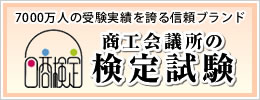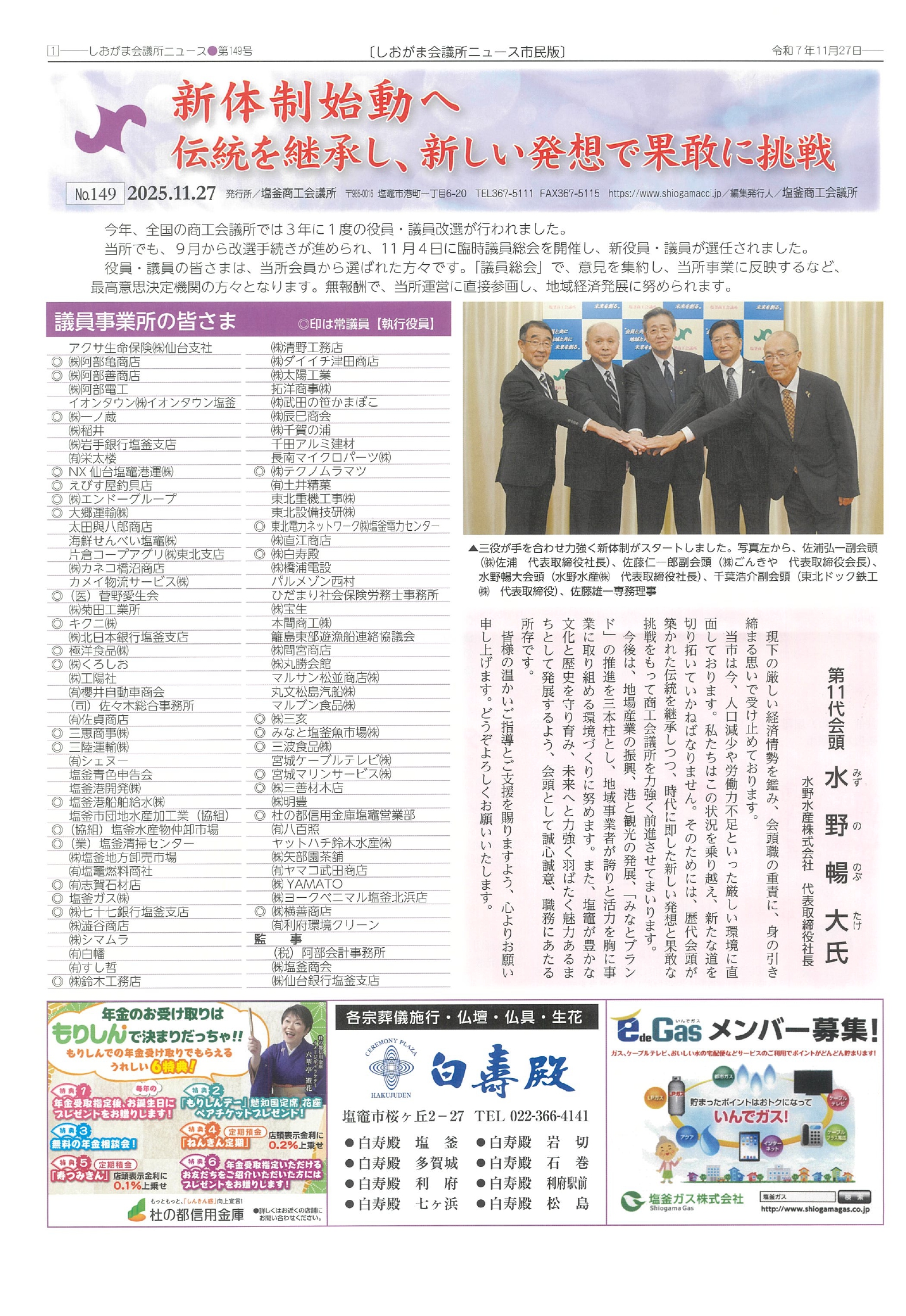丹野家の由緒
丹野(たんの)家の初代は六(ろく)右衛門(えもん)といい、西町にあった菓子舗古梅園(こばいえん)に生まれました。古梅園は、仙台藩に御用菓子を献上する老舗であったといいます。享保五年(一七二〇)頃、六右衛門は白坂(御釜神社の脇の坂道付近)で五十集(いさば)問屋(どんや)(海産物卸商)を開業したとされます。その後、漁船が着く大河岸(おおかし)を臨む現在地に移転し、船から揚がる海産物を買いつけて仙台に送り出したり、自ら廻船を所有して三陸沿岸から北海道方面まで海産物取引に赴くなどして商売を広げ、江戸時代後期には塩竈を代表する商家のひとつになりました。明治以後は魚肥(ぎょひ)の商いにも進出しましたが、戦時下の統制経済によって肥料取引からは撤退を余儀なくされました。戦後は店の立地を活かして鹽竈神社の参拝客を相手とする茶器商および塩竈銘菓を製造販売する菓子舗として今日に至りました。ご当主は代々六右衛門を襲名し、当地では丹(たん)六(ろく)さんと呼ばれて親しまれております。
銘菓志(し)ほかま
和菓子の世界では軟(なん)落雁(らくがん)を「しおがま」と総称し、今では全国各地で製造されていますが、もとは江戸時代の塩竈の名産品であった南京(なんきん)糖(とう)が始まりとされています。古梅園ではこれを「志ほかま」と称し、仙台藩主の鹽竈神社参詣の折にお茶うけとして献上していたそうです。また塩竈の地誌「奥(おう)鹽地(えんち)名集(めいしゅう)」では、塩竈銘菓として藻塩糖(南京糖)をあげ、西町の越後屋(えちごや)喜三郎(きさぶろう)が製造していたと記しています。戦後の昭和二十五年(一九五〇)、十代目六右衛門は古記録を調べて製造法を復元し、手作りの「銘菓志ほかま」の製造販売を始めて今日に至っています。
丹野家文書が伝える肴の道の歴史
江戸時代に五十集(いさば)問屋ならびに廻船(かいせん)問屋であった丹野家には百余点もの古文書が残されています。仙台湾の海産物が塩竈に一手に水揚げされ、馬の背に積まれて仙台城下に向かった「肴(さかな)の道」や、江戸および三陸諸港との交易の歴史を今日に伝えています。
丹六園の建物
現在の建物は大正三年(一九一四)年に建てられました。材料は江戸時代の建物のものを再利用し、重厚さが感じられます。軒下(のきした)には塩竈の町屋(まちや)建築の特徴である出(だし)桁(げた)もみられます。このように丹六園は向かいの佐浦酒造の石蔵や、隣の太田與(よ)八郎(はちろう)商店の店舗・醸造工場とともに、塩竈を代表する景観をみせています。
なおこの建物は、平成五年(二〇〇三)に塩竈市の塩釜文化景観賞を受賞、さらに平成二十六年(二〇一四)には国の登録有形文化財に指定されています。
令和元年十月 文 斎藤善之(東北学院大学教授)
設置 塩釜商工会議所
○英語(English)
History of Tanrokuen (the Tanno family)
The lineage of the Tanno family
The first generation of the Tanno family was Rokuemon, a man born to a
family running a confectionary shop called Kobaien, in Nishi-machi. It
is said that Kobaien was a long-standing sweets shop which served confectionaries
to the Sendai Domain. Around the 5th year of the Kyoho era (1720), it is
considered that Rokuemon opened Isaba wholesale (marine products wholesaler)
in Shirasaka (in the vicinity of the slope beside Okama-jinja Shrine).
Afterwards, he moved his business to its present location, which faces
the large riverbank, where fishing boats docked, and expanded his deals
through purchasing the marine products unloaded from the boats and then
sending them out to Sendai, as well as owning his own freight vessels and
proceeding from the Sanriku coast to the Hokkaido area in order to trade
those marine products; as a result he became one of eminent merchant families
representing Shiogama by the latter part of the Edo era. Although they
advanced into the business of fish fertilizer during and after the Meiji
era, they were forced to withdraw from the manure business due to the controlled
economy during wartime. After the war, they built up their position as
a teaware trader, dealing with worshipers visiting Shiogama-jinja Shrine,
by taking advantage of the location, and as a confectionary shop producing
and selling high quality sweets from Shiogama, all of which has continued
up to the present day. Every family head has assumed the Rokuemon name
as a successor to the master's name from generation to generation, and
has been popular amongst locals, being called Tanroku.
Famous Shihokama Cake
While Japanese confectionery art collectively refers to Nanrakugan dry
sweets as “Shiogama” (a dry confection of starch and sugar which is now
made nationwide), it is considered to have originated from Nankinto, sweets
which were a specialty of Shiogama in the Edo era. Kobaien called them
“Shihokama” and offered them in the form of tea cakes for the feudal lords
of Sendai Domain on occasions such as their visits to Shiogama-jinja Shrine.
In addition, a topographical map of Shiogama, “Oenchimeishu”, lists Moshioto
(seaweed salt and sugar, or Nankinto) as a specialty of Shiogama, describing
them as being made by Kisaburo of Echigoya House (a confectionary maker)
in Nishi-machi. In the postwar period, on the 25th year of the Showa era
(1950), Rokuemon Tanno the 10th (Judaime) checked historical records to
restore the original manufacturing method and began to produce and sell
what became known as the handmade “Famous Shihokama Cake”, which continues
to be made up to the present day.
The history of Fish Road, as told in the Tannos documents
More than 100 different ancient documents survive from the Tanno family
who was a fish wholesale dealer and a freight vessel wholesaler during
the Edo era. The documents tell us about the “Fish Road” through which
marine products from Sendai Bay, unloaded in Shiogama single-handedly,
were transported on horseback to Sendai-jo Castle, and the history of trade
with Edo city and various ports in the Sanriku area.
Tanrokuen Building
The current building was built in the third year of the Taisho era (1914).
The original materials from the building as it stood in the Edo era were
reused in which you can still feel the prominence of that time. Dashigeta,
a way of using beams which jut out from under a structure to makes the
structure of eaves deeper, are also seen as they characterize Machiya merchant
house buildings in Shiogama. In this way, Tanrokuen displays a landscape
representing Shiogama, together with the stone-made warehouse of the Saura
brewery facing it, and the store as well as brewing factory of the Otayohachiro
shop neighboring the building.
In addition, this building was given the Shiogama City Shiogama Cultural
Landscape award in the 15th year of the Heisei era (2003), and was designated
as a Registered Tangible Cultural Property of Japan in the 26th year of
the Heisei era (2014).
October of the first year of the Reiwa era (2019)
Article by Yoshiyuki Saito (professor at Tohoku Gakuin University)Organizer:
Shiogama Chamber of Commerce and Industry
○中国語(中文)
丹六園(丹野家)歷史
丹野家歷史淵源
丹野家第一代為六右衛門,其出生於西町的菓子鋪古梅園。
古梅園是給仙台藩提供御用菓子的老鋪。據説,六右衛門於享保5年(1720年)在白坂(御釜神社傍坡道附近)成立了五十集問屋(海產品批發商)。之後,地址遷至面向漁船靠岸碼頭大河岸的現地點。六右衛門從漁船購入剛打撈的海產品運往仙台,而且又憑藉自家擁有廻船,將海產品貿易範圍從三陸海岸拓展至北海道,到了江戶時代後期已成爲代表鹽竈的商家之一。
明治以後,又開始進軍魚肥市場。但戰時期間由於實行統制經濟不得不從肥料市場中退了出來。戰後,利用店鋪地點之便,以鹽竈神社參拜者爲對象,開始販賣茶器並製造販賣鹽竈銘菓,作爲茶器商和菓子舖代代相傳至今。代代宗主皆被命名為六右衛門,因而當地人親切地稱之爲丹六桑。
銘菓SIHOKAMA
在和菓子世界裏將軟落雁統稱爲「SIOGAMA」。現在,雖然日本全國各地都生產該和菓子,但是,其最初源於江戶時代鹽竈名特產南京糖。在古梅園將之稱爲「SIHOKAMA」,每當仙台藩主來鹽竈神社參拜之際,作爲御用茶點使用。另外,在鹽竈地誌「奧鹽地名集」中,藻鹽糖(南京糖)作爲鹽竈銘菓被提及,並表明由西町越後屋喜三郎製造。於戰後昭和25年(1950年),第十代六右衛門調查了相關歷史記錄並復原了製造方法,開始人工製造並販賣「銘菓SIHOKAMA」,一直延續至今。
丹野家文書中記載的肴道歷史
江戶時代,經營五十集問屋及廻船問屋的丹野家留下百餘件古文書。向今天的世人講述當時丹野家將仙台灣的海產從船上卸到鹽竈、之後托在馬背上前往仙台城下的「肴道」、以及與江戶及三陸諸港的貿易歷史。
丹六園的建築
現存的建築建於大正3年(1914年),所用材料是二次利用江戶時代建築物的舊材,散發著歷史的厚重感。屋簷具有鹽竈町屋建築的特點,即“出桁”(門廳部分的屋簷前伸)。丹六園與對面的佐浦酒造(釀酒厰)的石藏發酵槽、旁邊的太田與八郎商店的店鋪和釀造工廠一起成爲鹽竈代表性的景觀。
另外,於平成5年(2003年)該建築榮獲鹽竈市鹽釜文化景觀大獎,又於平成26年(2014年)被列入國家登錄有形文化財。
令和元年十月 文 齋藤善之(東北學院大學教授)
設置 鹽釜商工會議所
○韓国語(한국어)
단로쿠엔(단노 가문)의 역사
단노(丹野) 가문의 역사
단노 가문의 창시자 로쿠에몬(六右衛門)은 니시마치에 소재한 과자점 고바이엔(古梅園) 집안에 태어났다. 고바이엔은 센다이번에게 어용
과자를 납품한 유서 깊은 노포였다. 교호 5년(1720)경, 로쿠에몬은 시로사카(오카마 신사 곁의 비탈길 부근)에서 이사바 도매상(해산물
도매상)을 개업. 그 후, 어선이 도착하는 대선착장을 바라는 현재 위치에 이전하면서 어선으로부터 양륙한 해산물을 조달하여 센다이로
출하하거나 산리쿠 연안부터 홋카이도 방면까지 그가 소유한 운송선으로 해산물 거래로 왕래하는 등 장사를 펼쳐 에도 시대(1603-1867)
후기에는 시오가마를 대표하는 상가의 하나로 거듭났다. 메이지 시대(1868-1912) 이후는 어비 사업에도 진출했으나 전쟁하의
통제 경제로 비료 거래는 철퇴 할 수밖에 없었다. 제2차 세계대전 후는 가게의 입지를 활용해 시오가마 신사의 참배객을 대상으로
다기상 및 시오가마 명과를 제조 판매하는 과자점으로서 장사를 펼쳐 오늘에 이른다. 당주는 대대 로쿠에몬의 이름을 계승해 본고장에서는
‘단로쿠 산’이라는 호칭으로 사랑받고 있다.
명과 시호카마
일본 전통 과자 업계에서 <시오가마>는 난라쿠간 과자를 총칭하는 호칭으로 일컬어진다. 지금은 일본 각지에서 제조되고
있으나, 원래는 에도시대(1603-1867) 시오가마의 명산품 난킨토가 원조라 전해진다. 고바이엔은 이 과자를 <시호가마>라
칭해, 센다이번 영주가 시오가마 신사 참배 때의 다과로서 헌상했다. 또 시오가마 지지(地誌) 「오엔지 명집」에는 니시마치의 에치고야
기사부로가 시오가마 명과 모시오토(난킨토)를 제조했다는 기록이 남아있다. 제2차 세계대전 후의 쇼와 25년(1950), 제10대
당주 로쿠에몬은 고문서를 조사해 제조법을 복원, 수제 <명과 시호가마>의 제조 판매를 시작해 오늘에 이른다.
단노 가문 문서가 전하는 술안주의 길 역사
에도 시대(1603-1867)에 이사바 도매상 및 운송선 도매상이었던 단노 가문에는 백여 점의 고문서가 남아 있다. 시오가마에
한꺼번에 양륙한 센다이 만의 해산물을 말 등에 싣고 센다이 성읍을 향한 <술안주의 길>, 에도 및 산리쿠 지역의 여러
항구와의 교역의 역사를 오늘에 전한다.
단로쿠엔 건물
현재 건물은 다이쇼 3년(1914)에 축조되었다. 에도 시대(1603-1867)의 건물 자재를 재활용해 매우 중후함이 느껴진다.
처마 밑 구조는 시오가마의 마치야(점포겸 상가) 건축의 특징인 다시게타(出桁, 처마를 길게 뽑은 구조) 양식이다. 단로쿠엔은 건너편의
사우라 주조 돌 곳간, 옆 건물 오타 요하치로 상점의 점포와 양조 공장과 더불어 시오가마를 대표하는 경관으로서 그 자태를 선보이고
있다.
또한, 이 건물은 헤세이 5년(2003)에 시오가마시의 시오가마 문화 경관상을 수상, 헤세이 26년(2014)에는 일본 등록 유형
문화재로 지정되었다.
2019년 10월 글 사이토 요시유키(斎藤 善之, 도호쿠 학원대학 교수)
설치 시오가마 상공회의소
















